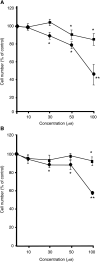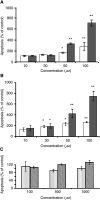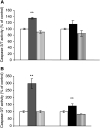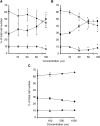Nitrogen-containing bisphosphonates inhibit cell cycle progression in human melanoma cells
- PMID: 15280922
- PMCID: PMC2364766
- DOI: 10.1038/sj.bjc.6602052
Nitrogen-containing bisphosphonates inhibit cell cycle progression in human melanoma cells
Abstract
Cutaneous melanoma is one of the highly malignant human tumours, due to its tendency to generate early metastases and its resistance to classical chemotherapy. We recently demonstrated that pamidronate, a nitrogen-containing bisphosphonate, has an antiproliferative and proapoptotic effect on different melanoma cell lines. In the present study, we compared the in vitro effects of three different bisphosphonates on human melanoma cell lines and we demonstrated that the two nitrogen-containing bisphosphonates pamidronate and zoledronate inhibited the proliferation of melanoma cells and induced apoptosis in a dose- and time-dependent manner. Moreover, cell cycle progression was altered, the two compounds causing accumulation of the cells in the S phase of the cycle. In contrast, the nonaminobisphosphonate clodronate had no effect on melanoma cells. These findings suggest a direct antitumoural effect of bisphosphonates on melanoma cells in vitro and further support the hypothesis of different intracellular mechanisms of action for nitrogen-containing and nonaminobisphosphonates. Our data indicate that nitrogen-containing bisphosphonates may be a useful novel therapeutic class for treatment and/or prevention of melanoma metastases.
Figures





Similar articles
-
Bisphosphonates induce breast cancer cell death in vitro.J Bone Miner Res. 2000 Nov;15(11):2211-21. doi: 10.1359/jbmr.2000.15.11.2211. J Bone Miner Res. 2000. PMID: 11092402
-
In vitro toxicity of bisphosphonates on human neuroblastoma cell lines.Anticancer Drugs. 2004 Sep;15(8):795-802. doi: 10.1097/00001813-200409000-00009. Anticancer Drugs. 2004. PMID: 15494642
-
The influence of bisphosphonates on viability, migration, and apoptosis of human oral keratinocytes--in vitro study.Clin Oral Investig. 2012 Feb;16(1):87-93. doi: 10.1007/s00784-010-0507-6. Epub 2011 Jan 12. Clin Oral Investig. 2012. PMID: 21225298
-
Bisphosphonate therapy in multiple myeloma: past, present, future.Eur J Haematol. 2002 Nov-Dec;69(5-6):257-64. doi: 10.1034/j.1600-0609.2002.02796.x. Eur J Haematol. 2002. PMID: 12460229 Review.
-
Bisphosphonates: biological response modifiers in breast cancer.Clin Breast Cancer. 2002 Aug;3(3):206-16; discussion 217-8. doi: 10.3816/CBC.2002.n.025. Clin Breast Cancer. 2002. PMID: 12196279 Review.
Cited by
-
Zoledronic acid induces apoptosis and S-phase arrest in mesothelioma through inhibiting Rab family proteins and topoisomerase II actions.Cell Death Dis. 2014 Nov 13;5(11):e1517. doi: 10.1038/cddis.2014.475. Cell Death Dis. 2014. PMID: 25393473 Free PMC article.
-
Ibandronate increases the expression of the pro-apoptotic gene FAS by epigenetic mechanisms in tumor cells.Biochem Pharmacol. 2013 Jan 15;85(2):173-85. doi: 10.1016/j.bcp.2012.10.016. Epub 2012 Oct 24. Biochem Pharmacol. 2013. PMID: 23103563 Free PMC article.
-
Bisphosphonate-loaded bone cement: Background, clinical indications and future perspectives.J Musculoskelet Neuronal Interact. 2022 Dec 1;22(4):587-595. J Musculoskelet Neuronal Interact. 2022. PMID: 36458394 Free PMC article. Review.
-
Prenylation inhibition-induced cell death in melanoma: reduced sensitivity in BRAF mutant/PTEN wild-type melanoma cells.PLoS One. 2015 Feb 3;10(2):e0117021. doi: 10.1371/journal.pone.0117021. eCollection 2015. PLoS One. 2015. PMID: 25646931 Free PMC article.
-
The effect of zoledronic acid and osteoprotegerin on growth of human lung cancer in the tibias of nude mice.Clin Exp Metastasis. 2006;23(1):19-31. doi: 10.1007/s10585-006-9008-z. Epub 2006 May 20. Clin Exp Metastasis. 2006. PMID: 16715352
References
-
- Aparicio A, Gardner A, Tu Y, Savage A, Berenson J, Lichtenstein A (1998) In vitro cytoreductive effects on multiple myeloma cells induced by bisphosphonates. Leukemia 12: 220–229 - PubMed
-
- Aznar S, Lacal JC (2001) Rho signals to cell growth and apoptosis. Cancer Lett 165: 1–10 - PubMed
-
- Bar-Sagi D, Hall A (2000) Ras and Rho GTPases: a family reunion. Cell 103: 227–238 - PubMed
-
- Benford HL, Frith JC, Auriola S, Monkkonen J, Rogers MJ (1999) Farnesol and geranylgeraniol prevent activation of caspases by aminobisphosphonates: biochemical evidence for two distinct pharmacological classes of bisphosphonate drugs. Mol Pharmacol 56: 131–140 - PubMed
-
- Benford HL, McGowan NW, Helfrich MH, Nuttall ME, Rogers MJ (2001) Visualization of bisphosphonate-induced caspase-3 activity in apoptotic osteoclasts in vitro. Bone 28: 465–473 - PubMed
Publication types
MeSH terms
Substances
LinkOut - more resources
Full Text Sources
Other Literature Sources
Medical

